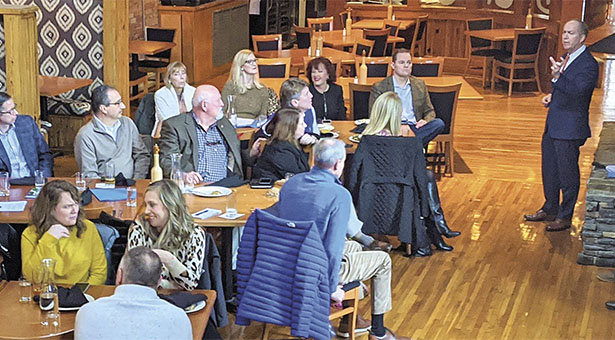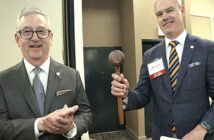Greenville Mayor Knox White addresses the Bristol Chamber Board of Directors.
Bristol Chamber Board picks the brains of the best and brightest in South Carolina’s upstate
by Scott Robertson
The scene could easily have been State Street. Two dozen or so Bristolians walked briskly through cold morning air on wide sidewalks alongside a two-lane main thoroughfare. But on the morning of February 20, the scene was unfolding about 150 miles south of Bristol in Greenville, South Carolina, and the Bristolians weren’t on their way to the Paramount or the Burger Bar. They were on a fact-finding mission in one of America’s success-story cities.
“Every other year the Chamber board typically engages in a retreat focused on board engagement and strategic planning,” explains Beth Rhinehart, CEO. “This year our Board Chair, Greg Neal (president of Ballad Health’s northeast market) suggested that we travel to Greenville S.C., on an intercity visit.
“Our Bristol 2040 recently completed an implementation plan and we hoped to visit and learn what Greenville was doing and to meet with their leaders to hear how they had achieved success as a city and to also hear what their challenges had been and continue to be,” Rhinehart says. “We wanted to meet with leaders to learn about their efforts in tourism, entrepreneurialism, workforce development, co-working ecosystems, chamber efforts and more.”
Greenville has parlayed the tax base of a county of 500,000 (the combined CSA of Johnson City, Kingsport and Bristol has a similar population size to Greenville County) into a tourism mecca and desirable, though increasingly unaffordable, place to live. By way of comparison, the combined hotel occupancy in the Tri-Cities increased around 1 percent last year, with an average daily rate (ADR) increase of 1.2 percent. Between 2011 and 2018, Greenville’s occupancy increased 15 percent despite a significant increase in the number of rooms available, and the ADR increase over that period was 51 percent.
Bristol’s question was simple: How do y’all do that?
The answer was more complicated.
First, Greenvillians bristle when the notion arises that the arrival of a BMW plant in 1994 was the sole driver of the community’s success. “We’ve had Michelin headquarters for years,” Greenville Mayor Knox White told the Bristol group over lunch at one of the first restaurants of the 120+ that now dot the downtown map. “We’ve had a good diversified manufacturing base, but the big picture is that we had very good leadership that was very intentional both in diversifying manufacturing and in downtown.”
Downtown was one of the things that was of most interest to the Bristol Chamber group. In the early 1980s, Greenville’s city government decided to reinvent downtown. Like most American cities at the time, the rise of suburban shopping malls had killed the downtown economy in Greenville. The department stores were all gone, replaced by bars of questionable repute and pawn shops.
When the city government announced a plan to bulldoze the existing four-lane Main Street to make room for wide sidewalks and a two-lane street, it was able to do so with little opposition because, as one city government official said, “there was nobody downtown left to complain.”
The Hyatt hotel chain built a hotel and convention center at one end of Main Street. The city built a performing arts center midway down the street. Eventually, a minor league ballpark was built at the other end of the street. “We did some clever things,” White told the Bristolians. “We took city owned parking lots and put those out to be built as mixed-use projects. We also concentrated on building second-floor residential space in those projects. We knew we’d never build critical mass, whatever that is, unless we had people on the street after five and on weekends, and you can’t do that without residential.”

Even the minor league baseball stadium, Fluor Field, has a mixed-use development just past the outfield wall. It was a critical part of getting the stadium built. The city also tore down a highway bridge that passed over a waterfall along the Reedy River downtown and replaced it with a footbridge, opening a park around the falls.
The river had been polluted for many years during Greenville’s run as the textile capital of the South, said Mary Douglas Hirsch, real estate development manager for the city. “With a clean-up effort and the building of the park, the river became an amenity.”
As residents began moving back downtown, the city strived to create what Hirsch calls, “a sense of place. We wanted an interesting experience on every corner and a real pedestrian orientation to downtown.”
By doing all those things, White said, the city “activated” its downtown. The only hiccup came when teens overran the park for a few weeks one summer, White said. A clever city staffer suggested having free bluegrass concerts in the park and the teens were gone within a couple of weeks.
The city’s success has been driven by its willingness to think entrepreneurially and invest in public-private partnerships, Hirsch said. “The city entered into agreements with developers that made sense in coordinating projects. That happens because people trust the government.”
It’s hard to argue the point. White has been mayor since 1995. Councilwoman Lillian Flemming, who also met with the Bristol group, has been in office since 1981.
Taxpayers have been willing to trust the government to enter into partnerships that have proven beneficial. The Upstate Alliance, a regional economic development effort around Greenville, for instance, encompasses ten counties and their smaller communities. “That organization is responsible for 50 percent of the leads generated,” said Mike Panasko, business development manager for the city. The region is glad when the state Department of Commerce brings in a prospect, Panasko said, but in the meantime, it recruits businesses that are good fits.
Another point of interest for Bristol Chamber board members was housing. The Bristol 2040 effort identified it as one of the twin city’s most pressing needs. Again, Greenville officials said, public private partnerships have been a huge part of the city’s success. The city works with developers, said Jenny Stroud, interim director of economic and community development. For instance, the city has purchased and demolished several dilapidated houses and worked with builders to replace them with up-to-date but affordable homes as part of neighborhood master plans.
Again, said Flemming, the citizens trust the city to do what’s right in those deals, in large part because Greenville has made a point of involving citizens in government. City leaders take part in around 40 neighborhood organizations where Flemming said hundreds of citizens will meet to ask questions about projects affecting them.
“We are very intentional about everything we do,” White said. “And it’s all about trust and relationships. Every big project has come about because of a relationship.”
Those relationships include a healthy city-chamber dialogue, and on the second day of the Bristol group’s two-day tour, the Greenville Chamber took over the hosting duties. Carlos Phillips, president and CEO, met with the group at the NEXT Innovation Center a few blocks away from the west end of Main Street. The main topic of conversation was workforce development and talent attraction and retention.

“Our unemployment rate right now in Greenville County is 1.9 percent,” Phillips said. “But, we have twice as many open jobs as we have eligible people to put in those jobs.” In an effort to address that, Phillips said, the Chamber has undertaken efforts to remove obstacles between employers and potential employees who are not currently part of the labor force.
The secret to filling those jobs, Phillips said is to “dig deeper into your community. You have to remove barriers between people who are outside the workforce participation pool and the jobs they could be doing.
“One barrier might be public transit,” Phillips said. “If you get a second shift job at the hotel downtown but the bus stops running after five, you can ride to work, but when that shift ends at nine, how are you going to get home? Affordable housing inventory is another barrier and the availability of affordable child care is another.”
Next on the agenda for the Bristol Chamber crew was a lunch with Jennifer Stilwell, executive vice president and chief strategic officer of VisitGreenvilleSC. Stilwell began by pointing out what others had said before her. Greenville did not set out to be a tourist destination. It set out to be a great place to live, and in doing so, became a place other people wanted to come to.
In fact, she said, the booming tourism industry there came about without the benefit of mountains, beaches, theme parks or any other traditional tourist draw. The city, she said, essentially built its market selling out of an empty wagon.
“When I got here, I asked, ‘So what’s my marketing budget?’” Stilwell said. “They said, ‘It’s 50.’ I said, ’50 what?’ and they said, ‘$50,000.’ I thought I had made the biggest mistake of my professional career.”
But Stilwell saw what was going on with Greenville’s downtown and realized that, if marketed properly, the town had a resource that would pay for itself many times over. The city encouraged restaurants to locate downtown and Stilwell marketed them to travel media. Soon sites like TravelZoo were proclaiming Greenville to be “one of our six favorite food cities in the U.S.” By 2018, Travel & Leisure declared Greenville one of 50 Best Places in the World to Travel.
That same year, the hotel occupancy rate peaked at 71 percent, the city had almost as many visitors for the year (500,000) as Greenville County had residents (510,000) and the average daily rate for a hotel room topped $100.
Of course, none of that would have happened had Greenville stayed with a $50,000 marketing budget. In fact, Stilwell’s organization now oversees $9 million a year in marketing investments. Again, Stilwell said, the citizens of Greenville and Greenville County are willing to make the investment because they see the benefit. The city and county charge visitors not only an accommodation tax, but also a hospitality tax. In 2018, accommodations tax revenue was $6.17 million and hospitality tax revenue topped $20.5 million.
“Tourism helps lift Greenville households’ tax burden by $895 annually in state and local taxes,” Stilwell said. “It creates more than 10,000 jobs and visitor spending benefits county residents with $273 million in wages and salaries.”
The Bristol Chamber group’s final stop was at a place where it finally was admitted that some of Greenville’s success has been sheer good luck. The Endeavor co-working space on the fourth floor of 1 North Main Street puts most other co-working spaces in America to shame. It has a gym with top of the line equipment. It has a commercial grade kitchen. The main lobby has a ceiling made of shined, decommissioned pennies. It has Italian marble desktops, tabletops and counters.
In 2014, that space had been the planned headquarters of CertusBank, an institution funded to the tune of $500 million by venture capitalists. The three executives who were in charge spent lavishly to create a haven of luxury for themselves. They spared no expense until a banking trade publication called attention to how quickly they appeared to be blowing through their capital. CertusBank was soon out of the space at 1 North Main, which sat vacant for more than a year before Joe Erwin, former president of Erwin-Penland Advertising decided to turn the space into a co-working space for creative and design professionals and freelancers.
As the Bristol Chamber contingent passed through the penny-ceilinged lobby on their way out, Erwin called their attention to a painting called, “The Quote.” He urged them to take its message to heart as they returned to Tennessee and Virginia. The painting includes, in foot high letters, a variation on the words of Nobel physicist Dennis Gabor: “The best way to predict the future is to invent it.”




